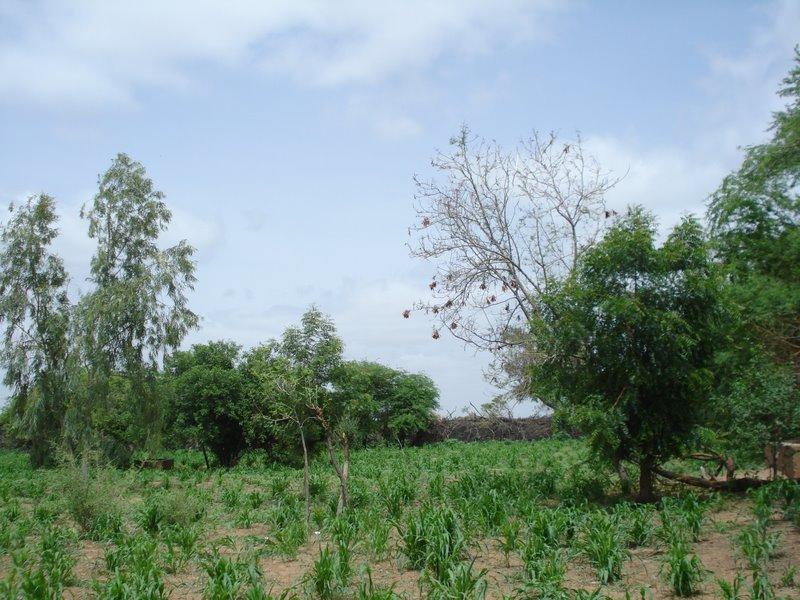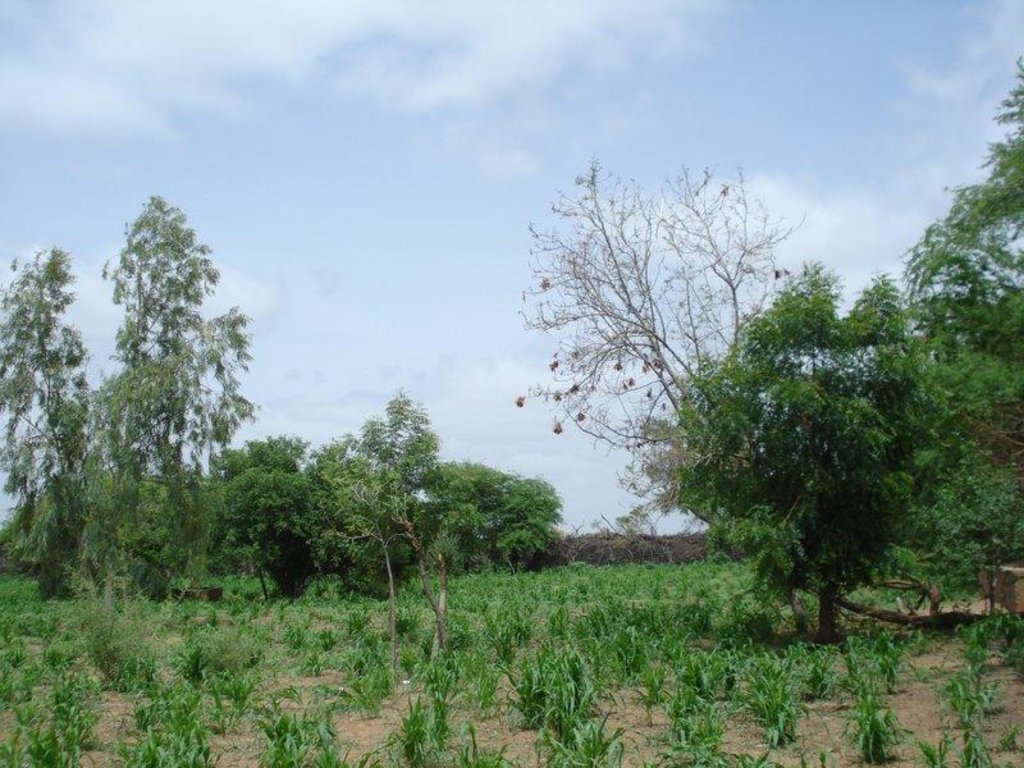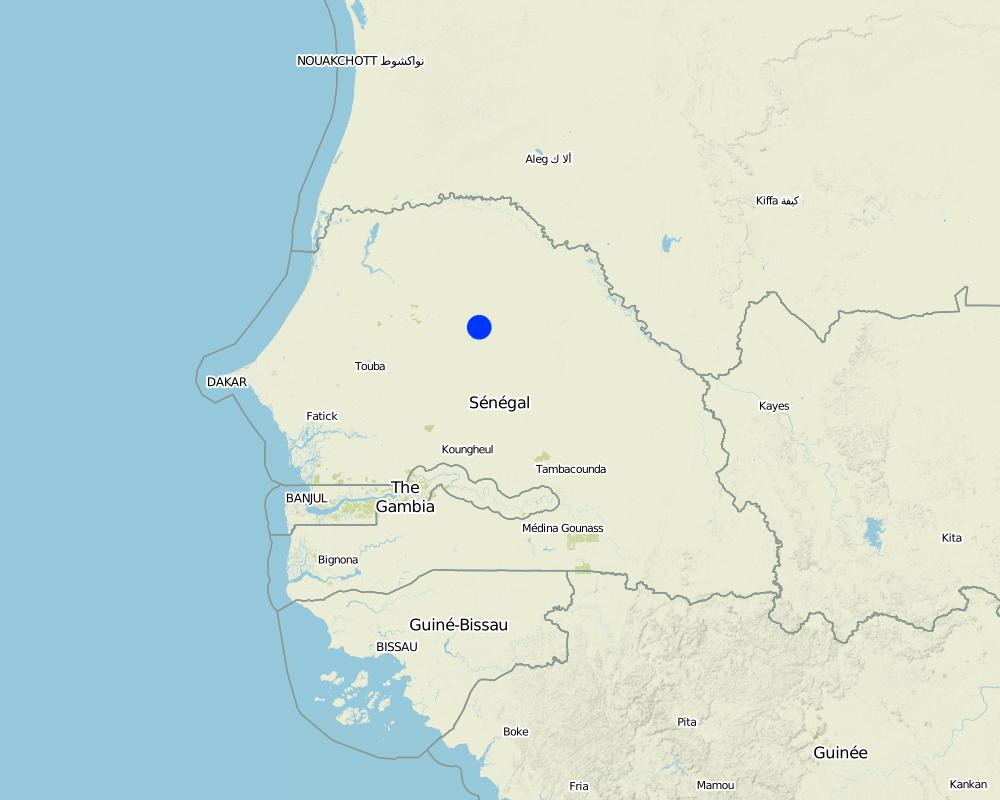Agroforestry community garden [塞内加尔]
- 创建:
- 更新:
- 编制者: Julie Zähringer
- 编辑者: –
- 审查者: Fabian Ottiger
technologies_1566 - 塞内加尔
查看章节
全部展开 全部收起1. 一般信息
1.2 参与该技术评估和文件编制的资源人员和机构的联系方式
SLM专业人员:
有助于对技术进行记录/评估的机构名称(如相关)
CDE Centre for Development and Environment (CDE Centre for Development and Environment) - 瑞士有助于对技术进行记录/评估的机构名称(如相关)
CSE (CSE) - 塞内加尔1.3 关于使用通过WOCAT记录的数据的条件
(现场)数据是什么时候汇编的?:
04/08/2009
编制者和关键资源人员接受有关使用通过WOCAT记录数据的条件。:
是
2. SLM技术的说明
2.1 技术简介
技术定义:
A plot under agroforestry with a rotation of horticulture (during the dry season) and millet (during the rainy season), enclosured and protected by a life fence of Prosopis juliflora
2.2 技术的详细说明
说明:
Main objectives are to increase the availability of vegetables in this zone far from the next market and to create an income source for women in the region. To mitigate the effects of wind erosion and gully formation in the plot and to protect it from cattle roaming a fence of dead wood and Prosopis juliflora seedlings has been constructed around it, which was meant to be a life fence after a certain time.
Establishment / maintenance activities and inputs: The initiative had been taken by a local "technicien agricole" which had assembled women of three villages and searched for local partenaires. The land on which the plot has been established was allocated to the group by the village chief. At the start, the project received support from the NGO Enda Tiers-Monde and the PAPEL (Projet d’Appui à l’Elévage) which has financed the construction of a small retention basin inside the plot to store water tapped from the local borehole. Each woman had the choice of construction 2m of the fence or to pay 1'000 CFA (US-Dollar: 2.25) compensation. Plot maintenance has been assured through the womens voluntary contributions. The extensive agent for "Water and Forest" has provided seedling of P. juliflora and other species on several occasions. Apart from expenses for seeds or seedlings for vegetable production the technology is not requiring any further financial inputs.
Natural / human environment: This SLM technology site is located in the sylvopastoral region of the Ferlo in the north of Sénégal. The agro-climatic zone is classified as semi-arid with mean annual precipitation of 300-400 mm. The main land use type in the area is extensive pastoralism followed by rainfed agriculture. Pastoralism is primarily practiced by transhumant Fula (Peulh) herders and further by Mauritanian Moor herders with herds of dromedaries. Vegetation cover in the area has largely been degraded due to cutting for domestic uses and cattle feeding, bushfires and overgrazing. The soil is exposed to wind erosion which carries away nutrients in the topsoil and therefore declines soil fertility. During intense rains in the rainy season, surface runoff is accelerated and leads to the formation of gullies and ravines. Quality of water sources has declined as they are being used by the local population for the purposes of body hygiene and laundry. Another factor of degradation are the oversized herds of dromedaries which consume large quantities of biomass, contribute to soil compaction due to the shape of their hooves and whose urine is perceived as noxious to the development of herb cover. Despite the various types of degradation, pastoralism and rainfed agriculture guarantee a certain food security for the local population and they have rarely experienced famines.
2.3 技术照片
2.5 已应用该技术的、本评估所涵盖的国家/地区/地点
国家:
塞内加尔
区域/州/省:
Louga
有关地点的进一步说明:
Barkédji
Map
×2.6 实施日期
如果不知道确切的年份,请说明大概的日期:
- 10-50年前
2.7 技术介绍
详细说明该技术是如何引入的:
- 通过土地使用者的创新
注释(项目类型等):
1991
3. SLM技术的分类
3.1 该技术的主要目的
- 改良生产
- 减少、预防、恢复土地退化
- 创造有益的经济影响
3.2 应用该技术的当前土地利用类型

混合(作物/放牧/树木),包括农林
- 农林业
主要产品/服务:
Major cash crop annual cropping: Millet, gombo, chilli, carrot, onion
Major food crop annual cropping: Millet, gombo, chilli, carrot, onion
Major food crop tree and shrub cropping: Balanites aegyptiaca, Ziziphus mauritania
注释:
Major land use problems (compiler’s opinion): degradation of vegetation cover with wind erosion as a consequence / during the rainy season intensive rainfall leads to gully and ravine formation and to accelerated surface runoff / water management: temporary ponds used for activities like laundry and body hygiene and at the same time as drinking water sources for man and cattle
Major land use problems (land users’ perception): limited access to water from borehole for irrigation purposes as cattle herds are always preferred
3.3 有关土地利用的更多信息
该技术所应用土地的供水:
- 雨养
注释:
Water supply: Also mixed rainfed - irrigated
每年的生长季节数:
- 1
具体说明:
Longest growing period in days: 120 Longest growing period from month to month: Jul-Oct
3.4 该技术所属的SLM组
- 农业林学
- 防风林/防护林带
- 轮作制度(轮作、休耕、轮垦)
3.5 技术传播
具体说明该技术的分布:
- 均匀地分布在一个区域
如果该技术均匀地分布在一个区域上,请注明覆盖的大致区域。:
- < 0.1 平方千米(10 公顷)
注释:
The plot located in the village of Diagali has a surface of about 0.5 ha
3.6 包含该技术的可持续土地管理措施

植物措施
- V1:乔木和灌木覆盖层
- V5:其它
注释:
Main measures: vegetative measures
Type of vegetative measures: aligned: -along boundary
3.7 该技术强调的主要土地退化类型

土壤水蚀
- Wg:冲沟侵蚀/沟蚀

土壤风蚀
- Et:表土流失
- Ed:风蚀风积

生物性退化
- Bc:植被覆盖的减少

水质恶化
- Ha:干旱化
注释:
Main type of degradation addressed: Et: loss of topsoil, Ed: deflation and deposition
Secondary types of degradation addressed: Wg: gully erosion / gullying, Bc: reduction of vegetation cover, Ha: aridification
Main causes of degradation: deforestation / removal of natural vegetation (incl. forest fires), over-exploitation of vegetation for domestic use (for domestic uses), overgrazing (oversized herds of cattle and dromadaires), population pressure, poverty / wealth (need for natural resources), education, access to knowledge and support services
Secondary causes of degradation: Heavy / extreme rainfall (intensity/amounts) (intense rains during rainy season)
3.8 防止、减少或恢复土地退化
具体数量名该技术与土地退化有关的目标:
- 防止土地退化
4. 技术规范、实施活动、投入和成本
4.2 技术规范/技术图纸说明
Technical knowledge required for field staff / advisors: moderate
Technical knowledge required for land users: moderate
Main technical functions: reduction in wind speed, increase of biomass (quantity), promotion of vegetation species and varieties (quality, eg palatable fodder)
Secondary technical functions: increase in organic matter
Aligned: -along boundary
Vegetative material: T : trees / shrubs
Number of plants per (ha): 84
Trees/ shrubs species: Prosopis juliflora (planteds)
4.3 有关投入和成本计算的一般信息
其它/国家货币(具体说明):
CFA
注明美元与当地货币的汇率(如相关):1美元=:
455.0
4.4 技术建立活动
| 活动 | 措施类型 | 时间 | |
|---|---|---|---|
| 1. | Establishment of tree nursery for P.juliflora | 植物性的 | |
| 2. | Bedding out of seedlings along plot boundary | 植物性的 |
4.5 技术建立所需要的费用和投入
| 对投入进行具体说明 | 单位 | 数量 | 单位成本 | 每项投入的总成本 | 土地使用者承担的成本% | |
|---|---|---|---|---|---|---|
| 其它 | Water | ha | 1.0 | 40.0 | 40.0 | |
| 技术建立所需总成本 | 40.0 | |||||
如果土地使用者负担的费用少于100%,请注明由谁负担其余费用:
NGO Enda Tiers-Monde, Papel and the governement agent for water and forest
4.6 维护/经常性活动
| 活动 | 措施类型 | 时间/频率 | |
|---|---|---|---|
| 1. | Pruning of P.juliflora | 植物性的 | |
| 2. | Growing more seedlings in tree nursery to improve strenght of fence | 植物性的 |
4.7 维护/经常性活动所需要的费用和投入(每年)
注释:
The cost of water applies to the need of the 0.5 ha plot and is only important in dry season when there is no other sources of water in the area. There is no other costs for the vegetation measures, as seedlings are given by the extensive agent for "Water and Forest" and all the women work on a voluntary basis
4.8 影响成本的最重要因素
描述影响成本的最决定性因素:
water from borehole for watering of seedlings in tree nursery
5. 自然和人文环境
5.1 气候
年降雨量
- < 250毫米
- 251-500毫米
- 501-750毫米
- 751-1,000毫米
- 1,001-1,500毫米
- 1,501-2,000毫米
- 2,001-3,000毫米
- 3,001-4,000毫米
- > 4,000毫米
有关降雨的规范/注释:
300-400 mm during one rainy season / dry season 8-9 months
农业气候带
- 半干旱
Thermal climate class: tropics, sylvopastoral zone of the Ferlo
5.2 地形
平均坡度:
- 水平(0-2%)
- 缓降(3-5%)
- 平缓(6-10%)
- 滚坡(11-15%)
- 崎岖(16-30%)
- 陡峭(31-60%)
- 非常陡峭(>60%)
地形:
- 高原/平原
- 山脊
- 山坡
- 山地斜坡
- 麓坡
- 谷底
垂直分布带:
- 0-100 m a.s.l.
- 101-500 m a.s.l.
- 501-1,000 m a.s.l.
- 1,001-1,500 m a.s.l.
- 1,501-2,000 m a.s.l.
- 2,001-2,500 m a.s.l.
- 2,501-3,000 m a.s.l.
- 3,001-4,000 m a.s.l.
- > 4,000 m a.s.l.
5.3 土壤
平均土层深度:
- 非常浅(0-20厘米)
- 浅(21-50厘米)
- 中等深度(51-80厘米)
- 深(81-120厘米)
- 非常深(> 120厘米)
土壤质地(表土):
- 粗粒/轻(砂质)
- 中粒(壤土、粉土)
表土有机质:
- 中(1-3%)
如有可能,附上完整的土壤描述或具体说明可用的信息,例如土壤类型、土壤酸碱度、阳离子交换能力、氮、盐度等。:
Soil texture: Coarse/light (sol sable-limoneux, sol instable) and medium
Soil fertility: Low (the soil pH is quite basic, it is really rare for this type of soil)
Topsoil organic matter: Medium (labile organic carbon of 0.24 g/kg)
Soil drainage/infiltration: Good
Soil water storage capacity: Low
5.4 水资源可用性和质量
地表水的可用性:
匮乏/没有
水质(未处理):
不良饮用水(需要处理)
关于水质和水量的注释和进一步规范:
Water quality (untreated): Poor drinking water (treatement required, groundwater accessed through borehole, mainly used in dry season, ranked 1) and for agricultural use only (irrigation, temporary ponds used during rainy season, ranked 2)
5.5 生物多样性
物种多样性:
- 中等
5.6 应用该技术的土地使用者的特征
生产系统的市场定位:
- 混合(生计/商业
非农收入:
- 收入的10-50%
相对财富水平:
- 贫瘠
- 平均水平
个人或集体:
- 合作社
机械化水平:
- 手工作业
性别:
- 女人
说明土地使用者的其他有关特征:
Land users applying the Technology are mainly common / average land users
Difference in the involvement of women and men: it's an initiative promoting women of all social classes
Population density: < 10 persons/km2
Annual population growth: 2% - 3%
2% of the land users are rich.
22% of the land users are average wealthy.
76% of the land users are poor.
Off-farm income specification: many women do small scale trading
5.7 应用该技术的土地使用者拥有或租用的平均土地面积
- < 0.5 公顷
- 0.5-1 公顷
- 1-2 公顷
- 2-5公顷
- 5-15公顷
- 15-50公顷
- 50-100公顷
- 100-500公顷
- 500-1,000公顷
- 1,000-10,000公顷
- > 10,000公顷
这被认为是小规模、中规模还是大规模的(参照当地实际情况)?:
- 小规模的
注释:
Average area of land owned or leased by land users applying the Technology: Also 2-5 ha (ranked 3)
5.8 土地所有权、土地使用权和水使用权
土地所有权:
- 州
- 个人,未命名
土地使用权:
- 社区(有组织)
用水权:
- 社区(有组织)
5.9 进入服务和基础设施的通道
健康:
- 贫瘠
- 适度的
- 好
教育:
- 贫瘠
- 适度的
- 好
技术援助:
- 贫瘠
- 适度的
- 好
就业(例如非农):
- 贫瘠
- 适度的
- 好
市场:
- 贫瘠
- 适度的
- 好
能源:
- 贫瘠
- 适度的
- 好
道路和交通:
- 贫瘠
- 适度的
- 好
饮用水和卫生设施:
- 贫瘠
- 适度的
- 好
金融服务:
- 贫瘠
- 适度的
- 好
6. 影响和结论性说明
6.1 该技术的现场影响
社会经济效应
生产
产品多样性
生产区域
水资源可用性和质量
灌溉用水需求
收入和成本
农业收入
收入来源的多样性
社会文化影响
食品安全/自给自足
社会经济弱势群体的情况
Improved livelihoods and human well-being
注释/具体说明:
Weak improvement of income
生态影响
水循环/径流
蒸发
土壤
土壤覆盖层
土壤有机物/地下C
生物多样性:植被、动物
生物量/地上C
植物多样性
减少气候和灾害风险
碳和温室气体的排放
风速
6.3 技术对渐变气候以及与气候相关的极端情况/灾害的暴露和敏感性(土地使用者认为的极端情况/灾害)
渐变气候
渐变气候
| 季节 | 气候变化/极端天气的类型 | 该技术是如何应对的? | |
|---|---|---|---|
| 年温度 | 增加 | 未知 |
气候有关的极端情况(灾害)
气象灾害
| 该技术是如何应对的? | |
|---|---|
| 局地暴雨 | 不好 |
| 局地风暴 | 不好 |
气候灾害
| 该技术是如何应对的? | |
|---|---|
| 干旱 | 不好 |
水文灾害
| 该技术是如何应对的? | |
|---|---|
| 比较和缓的(河道)洪水 | 不好 |
其他气候相关的后果
其他气候相关的后果
| 该技术是如何应对的? | |
|---|---|
| 缩短生长期 | 不好 |
6.4 成本效益分析
技术收益与技术建立成本相比如何(从土地使用者的角度看)?
短期回报:
中性/平衡
长期回报:
稍微积极
技术收益与技术维护成本/经常性成本相比如何(从土地使用者的角度看)?
短期回报:
稍微积极
长期回报:
稍微积极
6.5 技术采用
在所有采用这项技术的人当中,有多少人是自发地采用该技术,即未获得任何物质奖励/付款?:
- 90-100%
注释:
100% of land user families have adopted the Technology without any external material support
There is a little trend towards spontaneous adoption of the Technology
6.7 该技术的优点/长处/机会
| 土地使用者眼中的长处/优势/机会 |
|---|
| gives the women the possibility to gain some independance from their husbands and to improve family income |
| 编制者或其他关键资源人员认为的长处/优势/机会 |
|---|
|
the live fence serves as protection against wind speed, limits evapotranspiration and creates a favorable microclimat for millet and vegetable growth How can they be sustained / enhanced? reinforcement with Prosopis provided by "Water and Forest" |
|
the fact that trees in the plot were not cut down in order to gain space for cultivation helps to maintain biodiversity in the area and to a small extent sequester carbon How can they be sustained / enhanced? practice of assisted natural regeneration |
|
reafforestation with a variety of species provided by "Water and Forest" can help to increase vegetation cover in the area How can they be sustained / enhanced? training for planting techniques needed |
6.8 技术的弱点/缺点/风险及其克服方法
| 土地使用者认为的弱点/缺点/风险 | 如何克服它们? |
|---|---|
| access to irrigation water from the borehole is limited because of preference of cattle | better water management and distribution between cattle herders and cultivators of the plot |
| little knowledge of the agricultural technologies | more training for agricultural technicians in the area |
| very high mortality of fruit trees in the plot | research needed to find causes |
| 编制者或其他关键资源人员认为的弱点/缺点/风险 | 如何克服它们? |
|---|---|
| the plantation of trees in the plot does not follow any system | training |
| the life fence is instable and weak | reinforce the life fence with Prosopis |
| very low revenues because of fertility problems and therefore reduced plant growth | research needed to find causes |
链接和模块
全部展开 全部收起链接
无链接
模块
无模块




